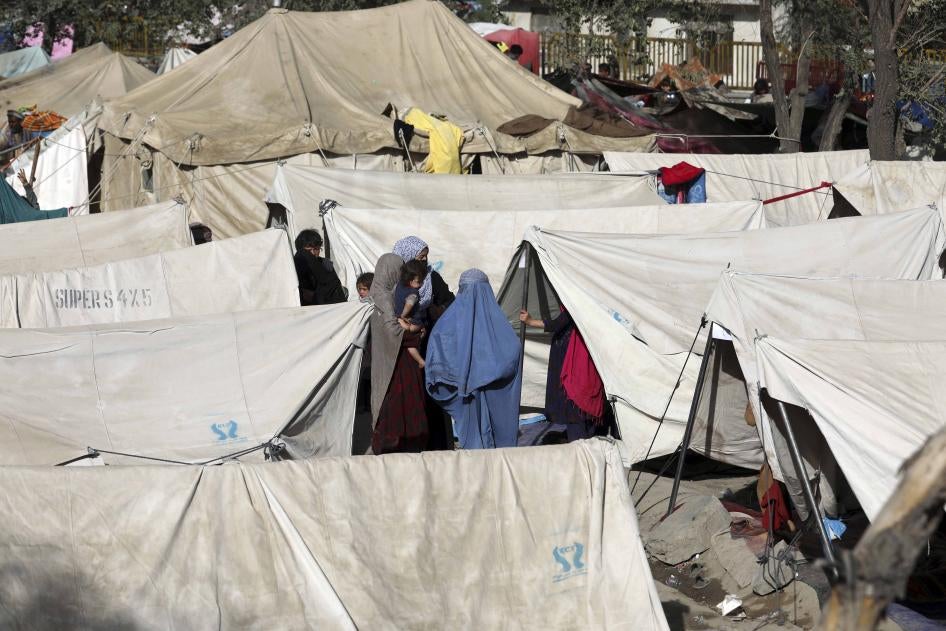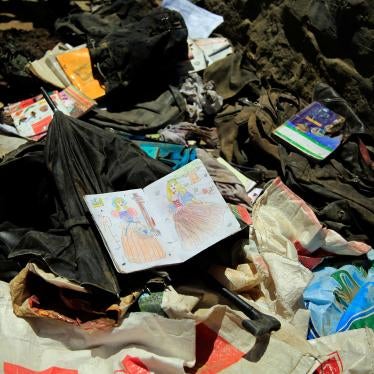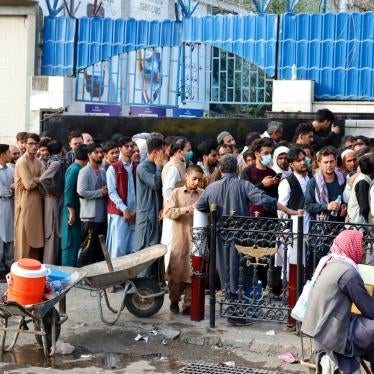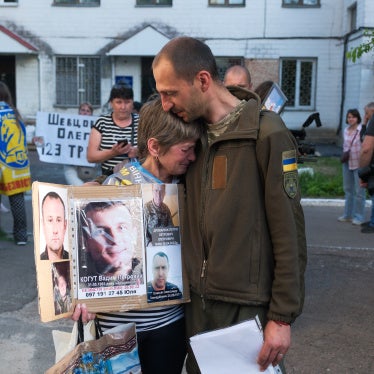This document was updated on September 9 to reflect that the United Nations Humanitarian Air Service has resumed operations internationally from Kabul airport and some domestic flights are operating. The media reported that on September 9, a Qatar Airways flight departed from Kabul’s international airport carrying around 200 passengers.
The Taliban takeover of Afghanistan in August 2021 caused tens of thousands of Afghans to flee, often by taking desperate measures. Many others who want to flee are still seeking secure safe passage out of the country. Countless Afghans remain at risk of being targeted for their past work or association with coalition forces, Afghanistan’s former government, international development programs, media, civil society, and other organizations promoting human rights. Women and girls and their families, especially those who fear that they can no longer work or study, are also motivated to flee the country.
The United Nations refugee agency (UNHCR) has projected that a half million Afghans may seek to leave by the end of 2021. Many Afghans fear persecution or reprisals under Taliban rule and hope to seek asylum or other pathways to safely migrate abroad. Some Afghans already outside the country are looking for temporary protection or permanent legal status abroad.
This question-and-answer document analyzes the policy responses of governments to Afghanistan’s refugee crisis from a human rights perspective.
- Who was evacuated from Afghanistan in August? Who remains?
- Are Afghans entitled to leave the country?
- Are all Afghans who leave the country entitled to refugee status?
- Which governments have pledged to resettle Afghans as refugees?
- What other options have governments made available to Afghans looking for visas?
- Why have governments moved some Afghans to third countries?
- What should governments do with respect to Afghans in their country?
- What can governments – and communities – do to welcome and integrate new arrivals?
In the days following the Taliban takeover in August, a US-led multinational airlift helped many international passport holders and Afghans to flee on hundreds of hastily coordinated evacuation flights from Kabul’s Hamid Karzai International Airport. US Pentagon officials said that the US-coordinated airlift evacuated nearly 125,000 people. Evacuees included many international staff of embassies and nongovernmental organizations, as well as others in the country holding foreign passports. But many thousands of Afghans who sought to flee, many of whom fear for their lives under Taliban rule, were not evacuated. Several hundred foreign passport holders are also believed to remain in the country.
Among Afghans who were evacuated with their families were those who had been granted visas linked to their service alongside coalition military forces or who had worked with foreign-funded programs. A smaller number of the Afghans seeking visas or asylum based on their fear of persecution due to their identity were also able to board planes as refugees, as were those with family members living as citizens abroad on the basis of family reunification.
Many Afghans who may have been eligible under these criteria were unable to secure a visa or a flight or get access to the airport in time. Most civilian evacuation efforts ended after a bombing attack outside the airport on August 27 killed scores of people.
Under international human rights law, everyone has the right to leave their own country, and everyone lawfully in a country has the right to liberty of movement within that country. Restrictions on these rights can only be imposed when provided by law, are for a legitimate purpose, and are a proportionate response to a legitimate government aim.
Taliban authorities have been quoted saying they do not want Afghans to leave the country. They have provided assurances that Afghan citizens with foreign travel authorization will be allowed to depart, however setting this requirement violates the right to freedom of movement.
On August 30 the United Nations Security Council adopted a resolution that expressed the expectation that “the Taliban will adhere to their commitments,” and referenced Taliban promises that:
Afghans will be able to travel abroad, may leave Afghanistan anytime they want to, and may exit Afghanistan via any border crossing, both air and ground, including at the reopened and secured Kabul airport, with no one preventing them from traveling, including regarding the safe, secure, and orderly departure from Afghanistan of Afghans and all foreign nationals.
It remains to be seen if the Taliban will adhere to these commitments. Kabul’s international airport is currently unable to operate. Qatar and Turkey are in talks with the Taliban about the management of Kabul airport, which lacks air traffic control services of its own. The United Nations Humanitarian Air Service has resumed operations internationally and some domestic flights are operating, and the media reported that on September 9, a Qatar Airways flight departed from Kabul’s international airport carrying around 200 passengers.
Otherwise, departure from the country is currently largely limited to attempts to cross land borders. Afghanistan’s eastern and southern borders with Pakistan were reopened on August 21. But Pakistani authorities have been reluctant to allow new Afghan refugees to enter, leaving large crowds waiting at the gates. The Pakistani government instead suggested that UNHCR should maintain camps on the Afghan side of the border.
On Iran’s western border with Afghanistan, media reports suggest that the authorities have set up temporary camps to receive Afghans. At least 1,000 Afghans are reported to have entered through the land crossing at Dogharoun, but Iranian officials have said that those who enter the country will be repatriated once conditions improve.
Turkmenistan, Uzbekistan, and Tajikistan lie to Afghanistan’s north. According to media reports, Afghan military pilots seeking asylum flew helicopters and planes into Uzbekistan and Tajikistan. Former Afghan government forces crossed a bridge into Uzbek territory that had been used by withdrawing Soviet forces three decades earlier. Uzbek authorities said that they were only offering a temporary transit point for Afghans, not accepting refugees, and have since closed their land border with Afghanistan. Similarly, Tajikistan established a tent camp for Afghans but only on a temporary basis.
No one should be forcibly returned to Afghanistan at this time, and all Afghans need at least temporary, if not permanent, legal protection.
Under the 1951 Refugee Convention, a refugee is someone who is unable or unwilling to return to their country of origin because of a well-founded fear of being persecuted based on race, religion, nationality, membership in a particular social group, or political opinion. Persecution based on gender, including gender discrimination and persecution based on lesbian, gay, bisexual, and transgender (LGBT) identity, can also form the basis for refugee status. The threat of being tortured or of inhuman or degrading treatment provides grounds for nonrefoulement (non-return) under international human rights law.
Often in situations of crisis, large groups of people are recognized as refugees on a so-called prima facie basis, meaning their refugee status is recognized simply based on their nationality or other shared characteristics. Countries can also provide people with temporary protection without making a refugee status determination.
All Afghan asylum seekers should be accorded refugee status on a prima facie basis or given access to fair and effective processes for determining their status and protection needs. At a minimum, they should be provided temporary protection while status determinations are pending.
Afghans have faced 40 years of war in their country, and many have been forced to flee, sometimes repeatedly, during those decades. At least 2.6 million Afghans were already living abroad as registered refugees, with the largest numbers in neighboring Pakistan, Iran, and Turkey. More than 3 million people had been internally displaced in Afghanistan by the end of 2020, and the UN refugee agency estimated that over 550,000 more Afghans were displaced within the country from the beginning of the year until August 10, including about 240,000 displaced since the withdrawal of coalition military forces began in May.
Over the years, most Afghans who have fled their country have been hosted by neighboring Iran and Pakistan. Others have made their way to Turkey, Germany, and India. At some points in the past, Afghans in Iran and Pakistan were recognized as prima facie refugees. But, due to inconsistent policy towards recognizing their status, most displaced Afghans in both countries today are not recognized as refugees.
As of July, Iran hosted 800,000 registered refugees and up to 3 million other displaced Afghans. Refugees and asylum seekers from Afghanistan have also faced abuses in Iran, including being prohibited from living in “no-go areas,” areas in most provinces off-limits to all non-citizens; being denied access to education; and being detained and deported without due process. Between 2019 and early 2021, Iran pushed almost 1.5 million Afghans back to Afghanistan, many involuntarily.
Pakistan has 1.4 million registered Afghan refugees and up to 2 million other displaced Afghans. For years, Afghans living in Pakistan have faced police abuse and forced returns.
Although jurisdictions vary in interpreting their obligations, Human Rights Watch considers the principle of nonrefoulement to extend to other serious risks to life and physical integrity arising from violence and exceptional situations. Countries receiving Afghans should adopt procedures to prevent the separation of children from their families, and to facilitate tracing and family reunification.
A number of governments have agreed to resettle refugees from Afghanistan:
- Canada has pledged to resettle up to 20,000 vulnerable Afghans, including women leaders, LGBTI people, journalists and people who assisted Canadian journalists, and human rights advocates who are already outside the country and who do not have a durable solution in a third country.
- The United Kingdom announced that it would accept 5,000 vulnerable Afghans in the first year, with a maximum of 20,000 in “the long-term" and that it intends to prioritize resettlement of “women, girls, children, and those likely to face human rights abuses by Taliban.”
- The Australian government has allocated 3,000 slots within the existing annual intake of 13,750 refugees.
- Mexico has committed to resettle over 100 journalists and the members of a female winning robotics team.
- Costa Rica announced that it would welcome women and girls from Afghanistan, and that a group of women affiliated with the United Nations Population Fund had already landed in the country.
- The US has yet to announce a specific resettlement pledge for Afghan refugees, but it has offered some Afghans who worked with US-based media or nonprofit organizations, or programs funded and supported by the US government with Priority 2 (P-2) processing for their refugee applications. The annual cap set by the US government for refugees from around the world in the fiscal year 2021, which ends on September 30, is 62,500. As of July 31, only 494 Afghans had been admitted in this year’s program.
Thus far, while small numbers of Afghan refugees have been granted access to European Union countries, for example, Ireland announced that it has allocated 150 Afghans a place in its refugee protection program, the EU has not made any commitments to resettle Afghan refugees. Instead, the European Council stated on August 31 that they want to cooperate with Afghanistan’s neighboring countries already hosting large numbers of refugees “to prevent illegal migration from the region, reinforce border management capacity and prevent smuggling of migrants and trafficking in human beings.” The council further said that “third-country national clauses in the readmission agreements between the EU and certain transit countries should be used where the legal requirements are met,” which seems to suggest that EU member countries should return Afghan asylum seekers to the third countries through which they transited.
UNHCR has said that “bilateral evacuation programs should not, however, overshadow or substitute for an urgent, and wider international humanitarian response.” The UN refugee agency should take the lead on coordinating and encouraging pledges to accept more refugees. Most Afghan asylum seekers will remain in neighboring countries and Turkey, but more affluent Western governments that fail to welcome Afghans as refugees risk eroding the willingness of frontline countries to do so. Donor countries should commit to fund services and support for Afghans in countries neighboring Afghanistan and in Turkey, to help share the responsibility.
According to a report in the Financial Times, the European Commission plans to allocate €600 million to Afghanistan’s neighbors, including Iran, Pakistan, Tajikistan, and Uzbekistan to help cover expenses generated by an influx of Afghans, and €300 million in humanitarian assistance in the country, largely earmarked for women and girls and other vulnerable groups. However, this greatly needed assistance should not serve as a justification for refusing to accept Afghan refugees within Europe’s own borders.
Regular pathways for a visa are available for Afghans, but as a practical matter, it has been incredibly difficult for them to secure documents authorizing travel. Taliban checkpoints, closed consulates, and documents destroyed for information security reasons have all hampered Afghans using traditional visa pathways. But those seeking to migrate can still pursue these pathways to secure a legal right to enter other countries, including student visas, performing artist visas, visiting scholar visas, and family reunification programs.
Some governments have announced new or emergency visa pathways specifically for Afghans. For example, Pakistan has offered visas to journalists and media workers seeking to leave Afghanistan. India announced an emergency online visa application available to all Afghans, which invalidated previously issued visas. Canada’s special program focuses on getting those who worked as interpreters or national staff at the embassy out of the country. The UK has offered relocation assistance to current and former locally employed staff, including those who lost their jobs due to the drawdown of operations.
South Korea evacuated and relocated hundreds of Afghans who had worked with them in Afghanistan, designating them persons of “special merit.” The German government has opened a program to provide current or former local staff of German ministries, development agencies and the military who were hired since 2013 with residency in Germany along with their core families. Other humanitarian lists will support individuals from vulnerable groups including journalists, human rights defenders and members of the political opposition to secure residency in Germany. Berlin estimates that tens of thousands of people still in Afghanistan are eligible for German residency. The German government reports that it does not know the exact number. At the same time, the European Council said it would focus on preventing “the recurrence of uncontrolled large-scale illegal migration movements faced in the past.”
The UK has acknowledged that there is an avenue to apply for admission on compassionate grounds outside the ordinary immigration rules. The UK should formally expand its Afghan Relocations and Assistance Policy to include a Category 5 cohort of eligibility to include all those at heightened risk of persecution from the Taliban. Expanding these kinds of programs would create greater certainty and provide a degree of transparency as to the applicable scheme and criteria.
The US Special Immigrant Visa (SIV) was established for those who had previously worked alongside the US military or government. Under US law, humanitarian parole is an alternative allowing some immigrants to enter the country temporarily and then seek asylum or complete other visa applications. On August 23, the US Department of Homeland Security announced that it would “parole certain Afghan nationals into the United States, on a case-by-case basis, for a period of two years and subsequent to appropriate vetting, provided their movement to the United States is being carried out pursuant to Operation Allies Refuge (the August 2021 airlift of 125,000 people conducted by the United States and its coalition allies).” The US government should adjust its policies so that Afghans allowed to enter the United States on humanitarian grounds are automatically provided work authorization, allowing them to integrate and secure livelihoods.
Countries considering Afghans for admission should not limit them to security personnel or interpreters who worked with US and coalition forces but should also include anyone who has fled because their activities, beliefs, or identity put them at risk of being persecuted under Taliban rule or face torture, inhuman or degrading treatment, or other serious risks to their lives and physical integrity. The EU, US, and other governments should demonstrate their commitment to host Afghans and permanently resettle them, through expanded visas, visa waivers, and by developing concrete plans to help Afghans reach those countries safely.
The US-led airlift out of Kabul’s airport relocated those evacuated from Afghanistan to “processing stations” in other locations, including Albania, Kosovo, North Macedonia, Colombia, Ecuador, Cambodia, and Uganda. In some cases, evacuees were taken to US or joint military bases in Qatar, Germany, Spain, Kuwait, and Italy for expedited processing. Spain has been serving as the processing hub for newly arrived Afghans evacuated by the European Union. The US government uses such sites to hold Afghans while it completes their paperwork for resettlement or visa applications, including background checks and security screening. It is unclear how long Afghans may remain in these third countries before being transferred to the countries willing to resettle them permanently.
Human Rights Watch has previously criticized sending asylum seekers to offshore processing locations, like the use of Nauru by Australia, because those policies have precluded asylum seekers from ever being allowed to enter the country, and stranded refugees in transit countries, often subject to arbitrary detention and other violations of their human rights. However, the current use of third countries expedited the Afghan airlift while still promising resettlement in other countries, including the United States.
Temporarily holding evacuated Afghans at US military bases or other government facilities can be appropriate if it remains time-limited and rights-respecting. Afghans being held at these processing stations should retain freedom of movement consistent with appropriate Covid-19 restrictions, access to health care, and adequate food, water, and shelter. Reports of overcrowding and poor sanitation conditions at the airbase in Doha, Qatar have raised serious concerns.
All governments should extend the residency status of Afghan nationals already in their country, enabling them to stay without facing the risk of deportation or detention. In line with UNHCR’s August 16 non-return advisory, no country should be deporting people to Afghanistan at this time. The US government should designate Afghanistan a country that triggers access to Temporary Protected Status, allowing Afghans already in the US to work legally and exempting them from immigration enforcement and detention, even if they overstay their existing visas. The EU should consider triggering the Temporary Protection Directive for Afghans, allowing them to remain for up to three years with the right to work and study. Canada has announced that it will prioritize applications to extend temporary residency status for Afghans already in Canada as visitors, students, or temporary workers.
International refugee law enshrines the principle of nonrefoulement, which prohibits returning people to situations where they are likely to be subject to persecution, torture, or other serious harm. Afghans who present themselves at any country's border or other port of entry seeking asylum should not be sent back without their claim being assessed in a full and fair procedure.
Anyone who expresses a wish for asylum or fear for their safety if returned to Afghanistan, regardless of whether a formal application has been submitted in their name or how this fear is expressed, should be given the chance to seek asylum. Asylum seekers, at a minimum, should receive temporary protected status to ensure that they will not be deported and will be authorized to work.
All countries should adopt a moratorium on deportations, and Afghans whose asylum applications had been rejected in the past should be given an opportunity to have their cases reheard based on changed circumstances. Most EU countries have officially announced a moratorium on returns to Afghanistan. Japan has also said that it will not deport Afghans, at least at present. In contrast, there have been reports of Uzbekistan returning Afghans to the country after receiving assurances from the Taliban.
Governments should not ignore the plight of Afghans stranded in limbo between the borders of two countries. Dozens of Afghans are stuck between Poland and Belarus, and the European Court of Human Rights has issued an interim order for the group to be provided humanitarian assistance. Turkey, by law, does not recognize any non-Europeans as refugees, but recognizes about 120,000 Afghans as “conditional refugees” with limited rights of movement and residence and limited opportunities to work. An estimated quarter-million undocumented Afghans are believed to be in Turkey, at risk of deportation. European and other governments should ensure access to asylum procedures for Afghan asylum seekers at their external borders and not trap them in limbo between countries.
Governments that have accepted Afghan asylum seekers should allocate sufficient funds to support local community-based groups hosting them. Programming for refugees should consider the psychosocial – mental health – needs of new arrivals, including the trauma of forced flight and the specific hardships they may have faced before and after leaving Afghanistan. Host countries should start providing refugee children education within three months of arrival, and remove any impediments to enrollment, such as documentary requirements. Donor countries should adequately fund emergency education. Unaccompanied minors should be supported to reunite with family members.
Mayors from cities and towns in Australia, Brazil, Cameroon, Canada, France, Germany, Italy, Nepal, The Netherlands, Palestine, Portugal, Scotland, Sierra Leone, Switzerland, Uganda, the UK, and the US issued a joint statement asking national governments to expand legal pathways for Afghans to migrate, support evacuations, decriminalize the journey of Afghan refugees, stop forcibly returning Afghans to their home country, and fund cities that are welcoming refugees.
The US government should commit sufficient funding from the Emergency Refugee and Migration Assistance (ERMA) account to enable Afghan community-based organizations and mutual assistance associations to support the reception and integration of newly arrived Afghans in the United States. In the past, ERMA funds have been instrumental in helping the US government scale up its support to refugees and internally displaced people from Syria, Somalia, and South Sudan. ERMA funding is an appropriation, drawn on to meet "unexpected urgent refugee and migration needs" whenever the president determines that it is "important to the national interest" to do so.
Governments should ask the UN High Commissioner for Refugees to convene an emergency summit as soon as possible to bring concerned countries together to discuss a coordinated plan to resettle Afghans, in particular high-risk people and their families, and funding for humanitarian needs in countries with large populations of fleeing Afghans, including Pakistan, Iran, and Turkey. EU Commission President Ursula von der Leyen said the European Commission was ready to provide funding to individual EU countries that agree to accept and resettle Afghan refugees. In September, the EU commissioner for home affairs will host a “High Level Resettlement Forum” to identify “sustainable solutions” for Afghans who are “most vulnerable,” particularly women, children, human rights activists, journalists, and lawyers.








